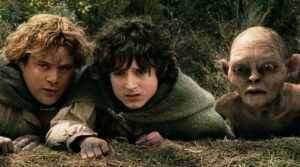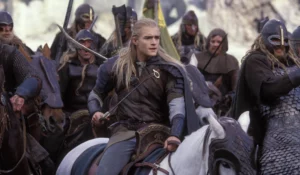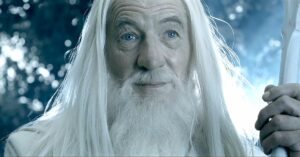The Lord of the Rings: The Two Towers (2002) review
Dir. Peter Jackson

By: Steve Pulaski
Rating: ★★★
NOTE: This is a review of the theatrical version of The Two Towers.
But in the end, it’s only a passing thing, this shadow. Even darkness must pass.
A new day will come. – Samwise Gamgee, The Lord of the Rings: The Two Towers
For my first viewing of the Lord of the Rings trilogy, I thought it wise to space the films apart a week. To me, that underscores the journey of the Fellowship. Moreover, it also gives me time to better process and appreciate each installment as its own entity, although there might not be a way to divorce the three films when all is said and done.
The Lord of the Rings: The Two Towers certainly exhibits some aspects of “middle chapter syndrome,” but even with those reservations, it’s an accomplished epic that methodically turns the temperature up on the characters, the battles, and the stakes a whole.
Picking up where The Fellowship of the Ring left off, The Two Towers shows the effects of the Fellowship splintering en route to Mount Doom to destroy the almighty One Ring. Aragorn (Viggo Mortensen), the heir of Isildur, has now more-or-less become the main character. It’s he, Legolas (Orlando Bloom), and Gimli the dwarf (John Rhys-Davies) who join forces as a rambunctious “Three Musketeers”-esque trio that embark to Rohan, where they rejoin Gandalf (Ian McKellen). Gandalf the Grey has become Gandalf the White following a battle with Balrog that leaves him with an ethereal, angelic glow following resurrection. Blessed so, Gandalf still has a job to do and souls to lead on this dangerous quest.

Hobbits Frodo (Elijah Wood) and Samwise (Sean Astin) remain by the side of one another even as the power of the One Ring starts to consume Frodo, rendering him aloof and inconsiderate at times. The two are joined by Gollum (Andy Serkis), a pathetic and feral creature who held possession of the Ring for 500 years. Now, he battles split-personalities — the obedient and childlike Sméagol vs. the evil and menacing Gollum — while longing for his “precious.” He dutifully leads the two Hobbits, much to the chagrin of Sam, who doesn’t trust the grotesque cretin.
That leaves Merry (Dominic Monaghan) and Pippin (Billy Boyd) to be rescued and nurtured by Treebeard the Ent (voiced by Rhys-Davies), whom they meet in Fangorn. Treebeard is a towering figure that moves as slowly as he speaks, informing Merry and Pippin that slowness is a virtue best embraced. I can now say I empathize with Randal Graves during his tirade against Lord of the Rings in Clerks II when he scoffs at a customer’s love for the trilogy with the deliciously accurate line: “even the fucking trees talked in those movies!”
Lurching over the storyline is the presence of Saruman (Christopher Lee), an Istari wizard responsible for waging war on Rohan following his alliance with Sauron. Saruman instructs an enormous army of Uruk-Hai warriors to battle against the fortress of Theoden (Bernard Hill). The Two Towers marches towards a climactic battle at Helm’s Deep, filled with armor, stakes, explosives, violence, and water. Lots of water.

Peter Jackson and his trio of writers commendably direct and guide this story, which technically has no real beginning nor end. We’re in the middle of this saga, but Jackson keeps things centered on warring factions and the continued development of Middle-earth. The Lord of the Rings trilogy was the introduction to computer-generated spectacles. Like all pioneers, it became often-imitated but seldom duplicated. The on-location photography of New Zealand makes Middle-earth feel like a lived-in world. As such, the constant threat of enemies, mythological creatures, and dangers that await our characters come across as realistic, thanks to the thoughtfully orchestrated verisimilitude of the region.
I was most captivated by the scenes involving Frodo and Sam. The film comes alive when Wood and Astin are on-screen together; two young performers playing novice and impressionable characters navigating a world with which they’re unfamiliar. That premise alone compels me as a movie-lover. Although I was initially irritated and slightly disturbed by the presence of Gollum, I came to appreciate his conflict as someone who spent five centuries with the Ring. When you see the effect it has on Frodo, seeing the effects it had on Gollum doesn’t necessarily seem too far-fetched.
I felt similarly to The Two Towers as I did Harry Potter and the Prisoner of Azkaban. The third installment of Harry Potter took a notably darker direction, which came not merely from the narrative but the director tasked with bringing the novel itself to the big screen. Increased was the spectacle, laudably so, but lost in part was the characterization that was built so gingerly in the previous installments. Peter Jackson’s sequel is extremely well-made, tactically staged, and yet another triumph of grand-scale filmmaking, but I felt more worn-down by its sullen tone and drearily gray visuals.
The colors, or lack thereof, bleed onto the characters, which occasionally feel less defined and more comparable to warrior archetypes. The settings are appropriately bleak, but don’t show the same kind of locational beauty present in The Fellowship of the Ring, especially when you consider the countryside of the Shire. I also don’t find Viggo Mortensen’s Aragorn to be as interesting as Frodo and Sam nor their plight. Frodo and Sam show the kind of vulnerability that makes great epics involving on a personal scale for most viewers. Aragorn seems to have most things, save for love, figured out, rendering him more impenetrable and less compelling on the surface.
With all that in mind, Jackson and his co-writers (Fran Walsh, Philippa Boyens, and Stephen Sinclair) have set the stage for a grand finale — one I’m confident will deliver on all fronts. The careful plotting and meticulously worldbuilding suggests the best is yet to come.
NOTE: As of this writing, The Lord of the Rings: The Two Towers is currently streaming on both Netflix and HBO Max.
My review of The Lord of the Rings: The Fellowship of the Ring
My review of The Lord of the Rings: The Return of the King
Starring: Elijah Wood, Ian McKellen, Liv Tyler, Viggo Mortensen, Sean Astin, Cate Blanchett, John Rhys-Davies, Bernard Hill, Christopher Lee, Billy Boyd, Dominic Monaghan, Orlando Bloom, Hugo Weaving, Miranda Otto, David Wenham, Brad Dourif, Karl Urban, and Andy Serkis. Directed by: Peter Jackson.
About Steve Pulaski
Steve Pulaski has been reviewing movies since 2009 for a barrage of different outlets. He graduated North Central College in 2018 and currently works as an on-air radio personality. He also hosts a weekly movie podcast called "Sleepless with Steve," dedicated to film and the film industry, on his YouTube channel. In addition to writing, he's a die-hard Chicago Bears fan and has two cats, appropriately named Siskel and Ebert!

